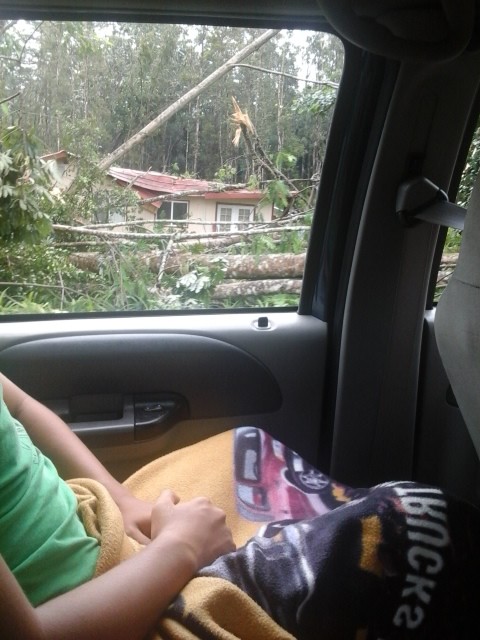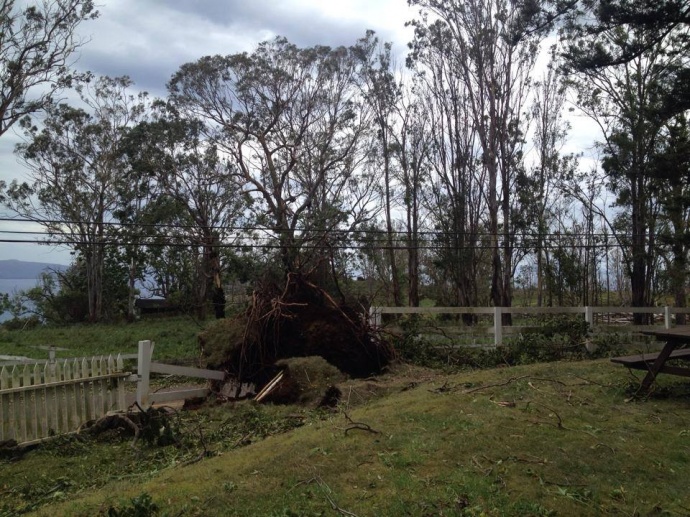Ask the Mayor: Why Trees at North Shore Parks Are Falling
The mayor answers questions from the public in this series.
By Mayor Alan Arakawa

Damage to a house from Hurricane Iselle on the Big Island. Photo courtesy of a Big Island Now reader.
Q: Last time we had a big storm pass through, I lost part of my roof. This time with Iselle, I was worried my home might have more damage. What’s the process for reporting storm damage?
A: Our Maui County Civil Defense Agency coordinates storm damage reports. This information ensures that the county has a complete picture of the scope of damage. The data collected will allow county officials to determine if our jurisdiction qualifies for any state or federal assistance, as well as to assist with flood plain mapping. However, please note that completion of a Damage Assessment Survey does not constitute an application for assistance. If your home or property sustained damage, you will still need to file a claim with your insurance company. To report damage caused by Tropical Storm Iselle, visit www.mauicounty.gov and click on the link to the online form. For more information or to request help with completing the form, call Civil Defense at 270-7285.
Q: Even before we had the recent storms, there were a lot of trees falling at Kanaha and Baldwin beach parks. Do you know why they were falling? Have they been maintained properly, or were they just old?
A: There are several reasons as to why trees have fallen at North Shore parks, but it all comes down to the site, the health of the tree, and the forces that are placed on the tree including wind, waves, gravity, soil conditions and activities in the area.
Kanaha Beach Park is exposed to the tradewinds that Maui is famous for with windsurfers and kiteboarders, and these trade winds are accelerated by the valley formation of the West Maui Mountains and Haleakala. The majority of trees that fell during the previous rains were located on the east end of Kanaha, which bears the brunt of the salt spray and gusty tradewinds. Shoreline erosion weakens the soil that anchors the trees, which then become unstable and hazardous to people.
Additionally, the moon phases during July, August and September are known as “super full moon” phases that cause leap tides to rise higher than at other times of the year. Kanaha Park itself is located in a wetland area, and saturated soils are significantly less able to anchor trees than dryer soil. Our county arborist informed me that when we have heavy rains, this area becomes saturated due to the very low water table. Further, the sandy soil makes it more difficult for the trees’ root systems to remain stable, while the sand is less able to provide a stable anchoring than clay.
A tree’s history also influences its risk of falling, such as when people dump hot coals at the base of the trunk, which kills the live vascular tissue and causes open wounds for rot to enter. Poor pruning in the past can also leave open wounds that may never completely heal, which causes the wood to rot internally. Past construction activities may impact root systems or scar a tree, causing wounds and allowing rot to enter.
Trees are living organisms and they are susceptible to injury and activities that take place around them. Caring for trees is an ongoing process that we must be mindful of to retain the trees that provide shade and natural habitat at our parks while ensuring the safety of park users.
Want to Ask the Mayor?
Submit your questions about County of Maui programs, services, operations or policies to Mayor Alan Arakawa via email: AskTheMayor@mauicounty.gov, phone: 270-7855 or mail: 200 S. High Street, 9th Floor, Wailuku, Hawaii 96793. Questions submitted will be considered for inclusion in the Ask the Mayor column.








